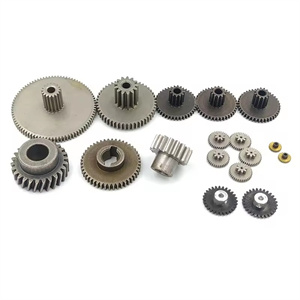Machining the production of double spur gears is a challenging and high-precision process. Double spur gears are often used in mechanical transmission to achieve complex speed changes and power transmission, such as in some heavy-duty machinery and high-precision machine tools. In terms of material selection, high-strength and wear-resistant alloy steels such as 40Cr or 20CrMnTi are usually used to meet their load-bearing and wear resistance requirements during operation. The manufacturing of rough parts is generally achieved through forging or casting, followed by rough machining to preliminarily form the shape of gears.
For the tooth profile machining of double spur gears, common methods include:
Gear hobbing: Using a gear hobbing machine and a suitable hob, accurately cut the tooth profile of the gear according to the principle of generation. In this process, it is necessary to strictly control the parameters of the hob and the motion accuracy of the hobbing machine to ensure the tooth profile accuracy and relative position accuracy of the two teeth of the double spur gear.
Gear shaping processing: For some special structures or parts with high precision requirements, gear shaping technology may be used to supplement processing.
During the machining process, precise clamping and positioning are required to ensure the coaxiality and phase relationship between the two teeth. For example, using specialized fixtures and high-precision measurement methods, real-time monitoring of dimensional and positional deviations during processing.
Heat treatment is also a crucial step, usually carried out through carburization and quenching or tempering to improve the hardness and comprehensive mechanical properties of gears.
After completing the heat treatment, precision machining processes such as gear grinding will also be carried out to further improve the accuracy and surface quality of the tooth surface.
In the main transmission system of high-end CNC machine tools, the accuracy and performance of double spur gears directly affect the machining accuracy and stability of the machine tool. Therefore, in the machining production process, every step needs to strictly follow the process specifications and quality standards. Machining and producing double spur gears requires advanced equipment, exquisite craftsmanship, and strict quality control to meet their high-performance requirements in various complex mechanical transmission systems.
Using CNC (Computer Numerical Control) machine tools to produce gears is an efficient and accurate manufacturing method. The following are the general steps for producing gears using CNC machine tools:
Design gears: First, you need to use CAD (Computer Aided Design) software to design gears. This includes determining key parameters such as the number of teeth, modulus, pressure angle, and tooth width of the gear.
Programming: Then, you need to convert the CAD design into code that CNC machine tools can understand. This is usually accomplished through CAM (Computer Aided Manufacturing) software. CAM software can convert CAD designs into G code or M code, which are instructions used by CNC machine tools to guide the machining process.
Choose cutting tools and fixtures: Select appropriate cutting tools and fixtures based on the material and design of the gear. Cutting tools are used to remove excess metal, while fixtures are used to fix gears on CNC machines to ensure stability during the machining process.
Set up CNC machine tool: Install the cutting tools and fixtures on the CNC machine tool, and adjust the parameters of the machine tool according to the gear design, such as cutting speed, feed rate, cutting depth, etc.
Start machining: Start the CNC machine tool and start the machining process. CNC machine tools will automatically perform cutting operations based on programmed instructions until gear machining is completed.
Inspection and testing: After the machining is completed, it is necessary to inspect and test the gears to ensure that their dimensions, accuracy, and performance meet the design requirements. This can be achieved by using various measuring tools and equipment, such as calipers, micrometers, gear measuring instruments, etc.
The use of CNC machine tools to produce gears has many advantages, including high precision, high efficiency, repeatability, and flexibility. CNC machine tools can be programmed and adjusted as needed to produce gears of different sizes, shapes, and materials. In addition, CNC machine tools can also achieve automated production, reduce labor costs, and improve production efficiency.
